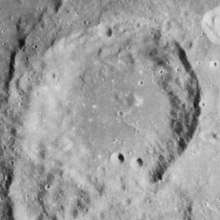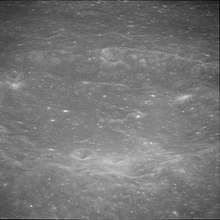Jansky (crater)
Jansky is a lunar impact crater that lies along the eastern limb of the Moon. It was named after American physicist Karl Jansky.[1] It lies due east of the larger walled plain Neper, along the southern edge of the Mare Marginis. Due to its location, this crater is viewed from the side from Earth, limiting the amount of detail that can be observed. The visibility is also affected by libration, which can completely conceal this formation from view.
 Lunar Orbiter 4 image | |
| Coordinates | 8.5°N 89.5°E |
|---|---|
| Diameter | 73 km |
| Colongitude | 272° at sunrise |
| Eponym | Karl Jansky |

This is a worn crater with an eroded rim. The southern part of the rim in particular is disrupted and irregular in form, with a pair of small craters along the inner wall. The remainder of the rim is roughly circular. The interior floor is relatively featureless, except for a few tiny craterlets.
Satellite craters
By convention these features are identified on lunar maps by placing the letter on the side of the crater midpoint that is closest to Jansky.
| Jansky | Latitude | Longitude | Diameter |
|---|---|---|---|
| D | 9.5° N | 91.2° E | 20 km |
| F | 8.8° N | 92.2° E | 50 km |
| H | 7.8° N | 91.3° E | 11 km |
References
- "Jansky (crater)". Gazetteer of Planetary Nomenclature. USGS Astrogeology Research Program.
- Andersson, L. E.; Whitaker, E. A. (1982). NASA Catalogue of Lunar Nomenclature. NASA RP-1097.CS1 maint: ref=harv (link)
- Bussey, B.; Spudis, P. (2004). The Clementine Atlas of the Moon. New York: Cambridge University Press. ISBN 978-0-521-81528-4.CS1 maint: ref=harv (link)
- Cocks, Elijah E.; Cocks, Josiah C. (1995). Who's Who on the Moon: A Biographical Dictionary of Lunar Nomenclature. Tudor Publishers. ISBN 978-0-936389-27-1.CS1 maint: ref=harv (link)
- McDowell, Jonathan (July 15, 2007). "Lunar Nomenclature". Jonathan's Space Report. Retrieved 2007-10-24.CS1 maint: ref=harv (link)
- Menzel, D. H.; Minnaert, M.; Levin, B.; Dollfus, A.; Bell, B. (1971). "Report on Lunar Nomenclature by the Working Group of Commission 17 of the IAU". Space Science Reviews. 12 (2): 136–186. Bibcode:1971SSRv...12..136M. doi:10.1007/BF00171763.CS1 maint: ref=harv (link)
- Moore, Patrick (2001). On the Moon. Sterling Publishing Co. ISBN 978-0-304-35469-6.CS1 maint: ref=harv (link)
- Price, Fred W. (1988). The Moon Observer's Handbook. Cambridge University Press. ISBN 978-0-521-33500-3.CS1 maint: ref=harv (link)
- Rükl, Antonín (1990). Atlas of the Moon. Kalmbach Books. ISBN 978-0-913135-17-4.CS1 maint: ref=harv (link)
- Webb, Rev. T. W. (1962). Celestial Objects for Common Telescopes (6th revised ed.). Dover. ISBN 978-0-486-20917-3.CS1 maint: ref=harv (link)
- Whitaker, Ewen A. (1999). Mapping and Naming the Moon. Cambridge University Press. ISBN 978-0-521-62248-6.CS1 maint: ref=harv (link)
- Wlasuk, Peter T. (2000). Observing the Moon. Springer. ISBN 978-1-85233-193-1.CS1 maint: ref=harv (link)
External links
| Wikimedia Commons has media related to Jansky (crater). |
- LTO-63B3 Jansky — L&PI topographic map